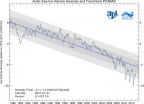(Press-News.org) Dallas, Feb. 13--The multidisciplinary team of scientists, who on November 24, 2012 announced the results of their five-year long study of DNA samples from a novel hominin species, commonly known as "Bigfoot" or "Sasquatch," publishes their peer-reviewed findings today in the DeNovo Journal of Science (http://www.denovojournal.com). The study, which sequenced three whole Sasquatch nuclear genomes, shows that the legendary Sasquatch is extant in North America and is a human relative that arose approximately 13,000 years ago and is hypothesized to be a hybrid cross of modern Homo sapiens with a novel primate species. A species name, Homo sapiens cognatus, has been applied for through ZooBank. "Cognatus," from the Latin "con" (with) and "natus" (born), means "blood relative."
The study, "Novel North American Hominins, Next Generation Sequencing of Three Whole Genomes and Associated Studies," was conducted by a team of experts in genetics, forensics, imaging and pathology. The team, led by Dr. Melba S. Ketchum of DNA Diagnostics in Nacogdoches, TX, included Dr. Pat Wojtkiecicz, Director of the North Louisiana Criminalistics Laboratory; Ms. Aliece Watts of Integrated Forensic Laboratories in Euless, TX; Mr. David Spence, Trace Evidence Supervisor at Southwestern Institute of Forensic Sciences; Dr. Andreas K. Holzenburg, Director of the Microscopy & Imaging Center at Texas A&M University; Dr. Douglas G. Toler of Huguley Pathology Consultants in Fort Worth, TX; Dr. Thomas M. Prychitko of Helix Biological Laboratory in Michigan; Dr. Fan Zhang of the University of North Texas Health Science Center; and Sarah Bollinger, Ray Shoulders, and Ryan Smith of DNA Diagnostics.
In total, 111 specimens of purported Sasquatch hair, blood, skin, and other tissue types were analyzed for the study. Samples were submitted by individuals and groups at 34 different hominin research sites in 14 U.S. states and two Canadian provinces. Ketchum's team sequenced 20 whole and 10 partial mitochondrial genomes, as well as 3 whole nuclear genomes, from the samples.
Mitochondrial DNA (mtDNA) comes from mitochondria, energy-producing organelles in the cellular cytoplasm, and is passed down on the maternal lineage across generations. Nuclear DNA (nuDNA) is the genetic information contained in the cell nucleus and is the equal combination of DNA from the parents of an individual.
Initially a skeptic, Ketchum implemented strict protocols to ensure the scientific integrity of the study. DNA was extracted from samples using forensic procedures followed by screening of the samples to rule out contamination. Subsequently, the Q30 quality scores for all three genomes sequenced using the Illumina HiSeq 2000 platform were well above the average Q30 score of 85, indicating that the DNA used in the next generation sequencing was highly purified and originated from a single source for each of the three genomes sequenced. Prior to DNA testing, forensics experts examined the morphology of submitted hair samples against known human and animal samples.
"We soon discovered that certain hair samples--which we would later identify as purported Sasquatch samples--had unique morphology distinguishing them from typical human and animal samples," says Ketchum. "Those hair samples that could not be identified as known animal or human were subsequently screened using DNA testing, beginning with sequencing of mitochondrial DNA followed by sequencing nuclear DNA to determine where these individuals fit in the 'tree of life.'"
After extensive forensic controls to prevent contamination, mtDNA testing of the Sasquatch samples yielded fully modern human profiles. Sixteen haplotypes indicating 100% homology with modern human mtDNA sequences were observed from 20 completed whole and 10 partial mitochondrial genomes. The human mtDNA results are consistent with previous, unrelated mtDNA tests of purported Sasquatch samples from other laboratories.
Next-generation whole genome sequencing with the HiSeq 2000 platform by Illumina was performed at the University of Texas, Southwestern on one tissue sample, a saliva sample and one blood sample to produce 3 whole genomes. In contrast to the mtDNA which was unambiguously modern human, the Sasquatch nuDNA results were a mosaic of novel primate and human sequence.
"While the three Sasquatch nuclear genomes aligned well with one another and showed significant homology to human chromosome 11, the Sasquatch genomes were novel and fell well outside of known ancient hominin as well as ape sequences," explains Ketchum. "Because some of the mtDNA haplogroups found in our Sasquatch samples originated as late as 13,000 years ago, we are hypothesizing that the Sasquatch are human hybrids, the result of males of an unknown hominin species crossing with female Homo sapiens."
Hominins are members of the taxonomic grouping Hominini, which includes all members of the genus Homo.
At the time of publication, study and analysis of the Sasquatch genomes is ongoing through the Sasquatch Genome Project (www.sasquatchgenomeproject.org). Further data will be presented as it becomes available. Dr. Ketchum is also launching the Global Sasquatch Foundation at www.melbaketchum.org, a research foundation dedicated to advancing public education and non-invasive study of the Sasquatch people, as well as the protection of their human rights.
###
"Novel North American Hominins, Next Generation Sequencing of Three Whole Genomes and Associated Studies."
Authors: Ketchum MS, Wojtkiewicz PW, Watts AB, Spence DW, Holzenburg AK, Toler DG, Prychitko TM, Zhang F, Bollinger S, Shoulders R, Smith R.
DeNovo. 15 February 2013.
Specimens yielding DNA were obtained, purportedly from elusive hominins in North America called Sasquatch. Sequencing and genotyping were performed in addition to histopathologic and electron microscopic examination of a large tissue sample.
Mitochondrial whole genomes were consistent with modern humans. In contrast, novel data were obtained when nuclear DNA was sequenced. Next generation whole genome sequencing was performed on three samples. Phylogeny trees generated showed homology to human chromosome 11 and to primate sequences. The data indicates that the Sasquatch has human mitochondrial DNA but possesses nuclear DNA that is a structural mosaic consisting of human and novel non-human DNA.
Corresponding authors are Melba Ketchum (science@sasquatchgenomeproject.org) and Aliece Watts (awatts02@charter.net)
To learn more about the Sasquatch Genome Project, visit sasquatchgenomeproject.org
3 'Bigfoot' genomes sequenced in 5-year DNA study
New research paper published today shows Homo sapiens/unknown hominin hybrid species extant in North America
2013-02-13
ELSE PRESS RELEASES FROM THIS DATE:
European satellite confirms UW numbers: Arctic Ocean is on thin ice
2013-02-13
The September 2012 record low in Arctic sea-ice extent was big news, but a missing piece of the puzzle was lurking below the ocean's surface. What volume of ice floats on Arctic waters? And how does that compare to previous summers? These are difficult but important questions, because how much ice actually remains suggests how vulnerable the ice pack will be to more warming.
New satellite observations confirm a University of Washington analysis that for the past three years has produced widely quoted estimates of Arctic sea-ice volume. Findings based on observations from ...
We're emotionally distant and that's just fine by me
2013-02-13
When it comes to having a lasting and fulfilling relationship, common wisdom says that feeling close to your romantic partner is paramount. But a new study finds that it's not how close you feel that matters most, it's whether you are as close as you want to be, even if that's really not close at all.
"Our study found that people who yearn for a more intimate partnership and people who crave more distance are equally at risk for having a problematic relationship," says the study's lead author, David M. Frost, PhD, of Columbia University's Mailman School of Public Health. ...
Video study shows which fish clean up coral reefs, showing importance of biodiversity
2013-02-13
Using underwater video cameras to record fish feeding on South Pacific coral reefs, scientists have found that herbivorous fish can be picky eaters – a trait that could spell trouble for endangered reef systems.
In a study done at the Fiji Islands, the researchers learned that just four species of herbivorous fish were primarily responsible for removing common and potentially harmful seaweeds on reefs – and that each type of seaweed is eaten by a different fish species. The research demonstrates that particular species, and certain mixes of species, are potentially critical ...
Penn vet team uncovers a pathway that stimulates bone growth
2013-02-13
PHILADELPHIA — Researchers from the University of Pennsylvania School of Veterinary Medicine have discovered that a protein called Jagged-1 stimulates human stem cells to differentiate into bone-producing cells. This protein could help both human and animal patients heal from bone fractures faster and may form the basis of treatments for a rare metabolic condition called Alagille syndrome.
The study, published in the journal Stem Cells, was authored by three members of Penn Vet's departments of Clinical Studies-New Bolton Center and Animal Biology: postdoctoral researchers ...
FASEB joins President Obama in urging Congress to sustain investments in research and innovation
2013-02-13
FASEB also praised the President's emphasis on increasing investments in science and innovation. President Obama said, "Now is not the time to gut these job-creating investments in science and innovation. Now is the time to reach a level of research and development not seen since the height of the Space Race." In addition, the President noted that the automatic spending cuts known as sequestration would devastate priorities like education, energy, and medical research. "We will continue our advocacy efforts to urge Congress to sustain federal funding for the National Institutes ...
Opera's poisons and potions connect students with chemistry
2013-02-13
Opera audiences can feel the chemistry in romance-inspired classics like Mimi's aria from La Bohème, Cavaradossi's remembrance of his beloved while awaiting execution in Tosca and that young lady pining for her man with "O mio babbino caro" in the opera Gianni Schicchi. An article in ACS' Journal of Chemical Education, however, focuses on the real chemistry — of poisons and potions — that intertwines famous operatic plots.
João Paulo André points out that opera, in addition to being a form of theater, can be used as a teaching tool for chemistry students and the general ...
Advance promises to expand biological control of crop pests
2013-02-13
A new discovery promises to allow expanded use of a mainstay biological pest control method, which avoids the health, environmental and pest-resistance concerns of traditional insecticides, scientists are reporting. The advance toward broadening applicability of the so-called sterile insect technique (SIT) appears in the journal ACS Synthetic Biology.
Luke Alphey and colleagues explain that the Lepidoptera, a large family of insects with a caterpillar stage, cause widespread damage worldwide to cotton; apples, pears and other fruits; and vegetable crops like broccoli, ...
Researchers discover biological diversity in triple-negative breast cancer
2013-02-13
CHAPEL HILL, N.C. – Triple-negative breast cancers are more biologically diverse than previously believed and classification should be expanded to reflect this heterogeneity, according to University of North Carolina researchers.
In a study published in the February issue of The Oncologist conducted by UNC and the Vall d'Hebron Institute of Oncology in Barcelona, Spain, a team lead by Charles Perou, PhD, of UNC Lineberger Comprehensive Cancer Center, examined more than 1,700 breast tumors, including 412 triple negative (TN) breast cancers, and concluded that triple-negative ...
Vitamin C is beneficial against the common cold
2013-02-13
Vitamin C seems to be particularly beneficial for people under heavy physical stress. In five randomized trials of participants with heavy short-term physical stress, vitamin C halved the incidence of the common cold.
Three of the trials studied marathon runners, one studied Swiss school children in a skiing camp and one studied Canadian soldiers during a winter exercise.
Furthermore, in a recent randomized trial carried out with adolescent competitive swimmers, vitamin C halved the duration of colds in males, although the vitamin had no effect on females.
Regular ...
Kinect teleport for remote medicine
2013-02-13
The Microsoft Kinect game controller could cut the US healthcare bill by up to $30 billion by allowing physicians and other medics to interact with patients remotely so reducing the number of hospital visits and the associated risk of infection.
Writing in the latest issue of the International Journal of Electronic Finance, Janet Bailey of the University of Arkansas at Little Rock is working with Bradley Jensen of Microsoft Corporation, in Irving, Texas, to explain how gaming technology could be used to "teleport" the knowledge and skills of healthcare workers to where ...
LAST 30 PRESS RELEASES:
Penn researchers awarded $25M to conduct trial using smartphones to fight heart disease
PCORI awards funding for new patient-centered healthcare research
Exploring the origins of the universe: 145 low-noise amplifiers complete ALMA telescopes
Empress cicada wings help illuminate molecular structure
Using sound waves to detect helium
Time burden in patients with metastatic breast and ovarian cancer from clinic and home demands
Researchers discover bias in AI models that analyze pathology samples
Scientists ID potential way to prevent brain injuries from triggering Alzheimer's
MASTER 2nd Open Call: Execution period kick-off
Algae for health in food and pharma
Advanced microrobots driven by acoustic and magnetic fields for biomedical applications
Chicago health information leader recognized for raising CPR readiness and blood pressure awareness
The Intimate Animal, a new book from Kinsey Institute Executive Director Dr. Justin Garcia
When blue-collar workers lose union protection, they try self-employment
New video dataset to advance AI for health care
MEA-based graph deviation network for early autism syndrome signatures in human forebrain organoids
New modeling approach sheds light on rare gut disease
Study documents potentially hazardous flame retardants in firefighter gear
Can certain bacteria regulate aging of the immune system and its related alterations?
AI model helps diagnose often undetected heart disease from simple EKG
There are fewer online trolls than people think
Cell membrane fluctuations produce electricity
Jeonbuk National University study shows positive parenting can protect adolescents against self-harm
Surface-engineered ZnO nanocrystals to tackle perfluoroalkyl substance contamination
This new understanding of T cell receptors may improve cancer immunotherapies
A new fossil face sheds light on early migrations of ancient human ancestor
A new immunotherapy approach could work for many types of cancer
A new way to diagnose deadly lung infections and save lives
40 percent of MRI signals do not correspond to actual brain activity
How brain-inspired algorithms could drive down AI energy costs
[Press-News.org] 3 'Bigfoot' genomes sequenced in 5-year DNA studyNew research paper published today shows Homo sapiens/unknown hominin hybrid species extant in North America


